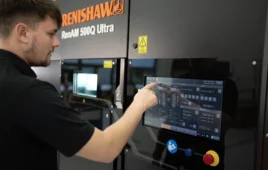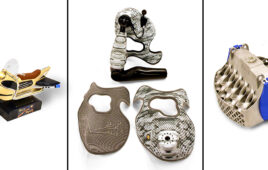The Space Enterprise Berkeley (SEB) team successfully launched their first-ever liquid-fueled rocket, Eureka-1, which reached 11,024 ft in December last year. The collegiate team partnered with Protolabs to create parts for Eureka-1’s plenum and complex parachute system using selective laser sintering (SLS).

“3D printing made sense for creating a part that could combine functionalities. It had to mount a parachute swivel, somewhat secure the avionics bay, and integrate a camera. That would’ve been a complex part with traditional manufacturing,” said Asa Garner, structures lead for SEB.
Garner used CAD to create the assembly design. He made a block diagram to show where the parts should be, and sub-teams with different requirements agreed on a general layout. Then, each team designed its individual parts in CAD to develop the general geometries. Garner knew that 3D printing would be the best solution for many parachute and outer plenum components.

“As soon as we realized we wanted to 3D-print these parts, I looked up all the datasheets for the various Protolabs materials. Then, I simulated options in nTopology and eventually settled on PA12 40% glass-filled nylon,” said Garner. “With PA12 glass-filled, we didn’t have to compromise on strength. We added a little bit more material than we would with metal, but it ended up being about the same weight and way easier.”
Aerospace commonly uses SLS and glass-filled nylon to make lightweight components, especially for rocketry and uncrewed drones. SLS provides material strength and consistency and is helpful for custom and complex parts. By building parts additively, engineers can skeletonize the designs and remove any mass that doesn’t contribute to the part’s functionality.
“As a practical measure, you can reduce the number of parts and decrease assembly times,” said Eric Utley, application engineer at Protolabs. “Initially, I thought people used 3D printing to save on CAD work and assembly. But once it scales up to a production setting, it also saves administrative time. For example, if an aerospace customer has a 13-piece component, they have 13 different purchase orders and must keep track of the 13 different vendors and their quality certifications. Extrapolate that to a larger product like a rocket. If you can go from 100,000 pieces down to 5,000 pieces, it’s tremendously less supply chain management.”
With 3D printing, design engineers can also accelerate product development by quickly creating parts, collecting feedback, and iterating on the design.
“Software developers started the mindset where you can roll out a product, and it doesn’t have to be perfect. You get it out there in people’s hands, then iterate and improve it. That mindset is trickling into hardware,” said Utley.

The SEB team used nTopology to simulate forces on the 3D-printed part and how the part would respond when the parachute opened. They assessed how it would handle stress and located stress concentrations or peaks. Using a lattice design, they could smooth out such peaks, dissipating stress across the part and leveraging the material efficiently.
“By changing the lattice thickness, you can make a part stiffer or softer,” said Utley. “If you design in CAD, it’s a rapid change, and you’re not constrained by manufacturing.”
In addition to SLS, the SEB team uses multi-jet fusion (MJF) for its LAD rocket program.
“At the peak of that program, we were cranking out a LAD rocket almost every week, which is astounding. That would’ve been impossible without 3D printing,” said Garner.
Garner projects that SEB will use a combination of various 3D printing methods and CNC machining to create durable, lightweight, multi-function parts for future projects. And they’re busily working on their second installation, Eureka-2, scheduled to launch in the fall of this year.
Watch the exciting Eureka-1 launch video:
Space Enterprise at Berkeley
berkeleyse.org
Protolabs
protolabs.com
Filed Under: Make Parts Fast




